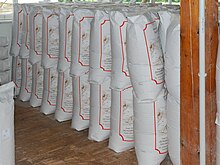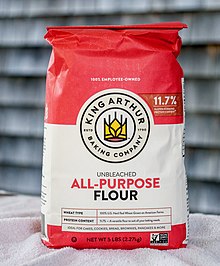
Bags or sacks for flour range in size and material, from large bulk bags, in cotton or woven polypropylene, to smaller consumer packaging, often made of paper.
Package types
Bulk packaging

Flour is often shipped from the miller to bakeries, institutions, and other bulk uses. Sizes range from 10 kg to 100 kg. One traditional construction was cheap cotton bags. These printed cotton bags were sometimes viewed as collectables; other times the flour sack fabric was repurposed into a variety of household items.
Current practices are to use multi-wall paper sacks. Some include a layer of plastic film for barrier properties and insect control. Woven polypropylene bags are also used for high strength; at least one variety (Purdue Improved Crop Storage bags) also includes inner plastic bags.
Consumer packaging

Consumer packages are often bags or sacks constructed of paper. Plastic films are also used, sometimes with reclosable features. Stand-up pouches of flour have recently been introduced.
Considerations
Contents
A wide variety of wheat flour are available. Flour can also be made from other grains, roots, nuts, etc. Packaging engineers and food scientists need to understand the properties of the particular flour, intended handling and logistics systems, and desired shelf life. Package forms and materials can be matched to these needs.
Insects

Insects can be a problem. When available, a suitable insecticide can be used; care must be used to ensure product safety. Hermetic plastic bags also help. When insect infestation is noted, one method of stopping further growth is to freeze the sacks of flour for several days.
Cultural impact

- Flour sack fabric has been used as a cheap source of fabrics for consumers to create their own textiles.
- Printed cotton bags were sometimes viewed as collectables.
- Various place names were named after flour sacks, since they were so ubiquitous in so many cultures. Blatobulgium in Scotland, and Pieniężno in Poland, for example, are possibly named after words for flour sack in different languages. The all-white tower in the old city of Ravensburg in Germany is called Mehlsack.
- Reuel Colt Gridley famously carried a 50-pound bag of flour on his shoulder after losing a political bet in Austin, Nevada. The sack of flour was later auctioned off, then re-donated, then re-auctioned again and again to raise money for the United States Sanitary Commission during the American Civil War. Auctioning this single flour sack eventually raised more than $250,000.
References
- Peetrak, L (11 May 2017). "Flour companies rethink packaging". Baking Business. 99 (1): 64–69. Archived from the original on 13 January 2023. Retrieved 1 October 2022.
- HRUŠKOVÁ, M (2002). "Changes of Wheat Flour Properties during Short Term Storage" (PDF). Czech J. Food Sci. 20 (4): 125–130. doi:10.17221/3522-CJFS. Archived (PDF) from the original on 17 June 2022. Retrieved 15 October 2022.
- Vanhanen, L (2006). "The use of peroxide value as a measure of quality for walnut flour stored at five different temperatures using three different types of packaging" (PDF). Food Chemistry. 99 (1): 64–69. doi:10.1016/j.foodchem.2005.07.020. Archived (PDF) from the original on 13 January 2023. Retrieved 1 October 2022.
- Cooke, Linda (March 1998). "Pest-Proofing Food Packaging" (PDF). Agricultural Research. Archived (PDF) from the original on 2012-10-04. Retrieved 2022-10-15.
- Baributsa, D (2022). "Hermetic Bags Help Afghan Rural Women Preserve Wheat Flour during Winter". Insects. 13 (3): 237. doi:10.3390/insects13030237. PMC 8953509. PMID 35323535.
- Lu, Jianhua (May 2015). "Effect of Wheat Flour Packaging Materials on Infestation by Lasioderma serricorne (F.)". Journal of Food Protection. 78 (5): 1052–1055. doi:10.4315/0362-028X.JFP-14-438. PMID 25951407. Archived from the original on 9 November 2022. Retrieved 7 November 2022.
- Flinn, P W (2015). "Cold temperature disinfestation of bagged flour". Journal of Stored Products Research. 63: 42–46. doi:10.1016/j.jspr.2015.06.001. Archived from the original on 15 October 2022. Retrieved 15 October 2022.
- Lea, Ralph & Kennedy, Christi (1 October 2005). Reuel Gridley and a sack of flour Archived 2020-05-31 at the Wayback Machine, Lodi News-Sentinel